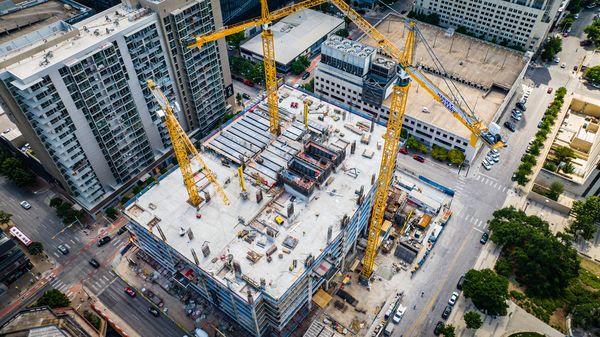High winds are not just a weather concern in the construction industry but also a significant safety hazard. Understanding and managing these risks is crucial to protecting workers and ensuring project integrity.
Keep reading to learn effective “high wind safety construction” practices and compliance tips to keep construction sites safe. If you or a loved one are hurt on the job, contact our Suffolk County construction accident lawyers at (631) 543-7070.

The risks of high winds in construction
High winds can impact construction sites, creating hazardous conditions that can lead to injuries or even fatalities. Here are some of the main safety risks associated with high winds in construction:
- Falling debris: Wind can dislodge tools, building materials, and debris from heights, posing risks to everyone on the site.
- Structural instability: Temporary structures like scaffolding can become unstable and collapse under strong winds.
- Impaired equipment operation: High winds can affect the safe operation of cranes and other heavy machinery, increasing the risk of accidents.
- Reduced visibility: Dust and debris from strong winds can reduce visibility, making it difficult for workers to see potential hazards.
High wind safety construction: Compliance and regulations
In New York, specific regulations address the safety measures that must be in place on construction sites to mitigate the risks associated with high winds. New York’s Industrial Code Rule 23 mandates that all construction sites have measures to secure material and equipment and outlines specific requirements for cranes and other machinery operations during windy conditions.
Safety tips for construction workers off the ground
Working at heights increases the risks during high winds. Here are essential safety tips for construction workers off the ground:
- Secure all materials: Before wind speeds increase, secure tools and materials to prevent them from becoming airborne. Use netting, tie-downs, or weights as necessary.
- Inspect scaffolding and temporary structures: Ensure all scaffolding is secured and meets the safety standards for withstanding wind loads. During windy conditions, regular inspections should be increased in frequency.
- Limit exposure to heights: When wind speeds exceed safe operational limits (generally around 20-25 miles per hour), cease work at heights. Always refer to the specific guidelines set out by the equipment manufacturers and site-specific regulations.
- Wear appropriate safety gear: Helmets, goggles, and other personal protective equipment can provide essential protection from flying debris.
- Use wind monitoring tools: Employ anemometers or other wind gauges to monitor wind speeds accurately on-site. This technology can provide real-time data to help make informed decisions about when to halt operations.
Implementing a high wind safety plan
- Training and education: Ensure all workers know the dangers of working in high winds and understand the safety protocols.
- Emergency response plan: Develop and communicate a clear plan for what to do if wind conditions become hazardous. This plan should include safe places to take shelter and procedures for securing the site quickly.
- Regular communication: Keep lines of communication open during high wind conditions to relay real-time information about the changing environment.
Hurt on a construction site? Carner & DeVita can help.
Construction firms must continuously update their safety protocols based on the latest industry standards and regulatory requirements to protect their workers and minimize the risks associated with high winds.
For those affected by construction-related incidents in high winds, Carner & DeVita is proud to provide expert legal representation, ensuring that workers receive the compensation and support they deserve. Contact us online or call (631) 543-7070 to schedule your free consultation today.
